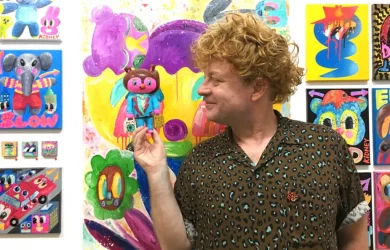
Originally published on metropolis.co.jp on November 2010





Even in the age of digital communication, Japan’s love affair with paper endures. Case in point: at the second Tokyo Art Book Fair in July, throngs of visitors turned up to inspect the slick wares exhibited by top dogs of the local art-publishing world. Even more interesting, though, were the racks in the lobby on which hundreds of zines were hung laundry-style.
Hundreds of what?!?
Long before the rise of the internet, a whole community of DIY publishers more or less did the same thing bloggers do today, but on paper. Like all the genuine underground networks, Zinedom is a sort of parallel universe that, despite counting thousands of practitioners around the world, goes largely undetected by the mainstream media. Even today, most of these inexpensive publications are created in limited numbers—either in the classic cut-and-glue style or with the help of a computer—by a single person who is responsible for the entire production process. That means generating all the content, then photocopying, folding, stapling and, finally, distributing each copy, either by trading with fellow zine makers or through mail order catalogues, a.k.a. “distros.”
Even though Japan has a long, rich tradition of angura (underground) publishing, it is relatively underrepresented in the world of zines. Sure, the uniquely Japanese phenomenon of dojinshi—self-published fan comics—is close in spirit to the zine ethic. But where a single dojinshi can sell hundreds, even thousands of copies, most zines have a print run of 100-150. With a lack of widespread interest in the medium, English-language titles by Japanese zinesters are almost nonexistent. Yet a small but enthusiastic expat contingent are committed to keeping the flame of DIY publishing burning in Japan.
Jong Pairez is a six-year Tokyo resident who started making zines when he was an art student in the Philippines in 2002. “My drinking buddies and I planned to publish a monthly journal as an alternative to the arrogant art establishment,” he explained to Metropolis during the Mini Zinester Gathering, held in July at a cafe in Shinjuku. “Unfortunately, most of my friends were only serious about drinking and ranting about the Manila art scene, so I decided to do everything myself. The project eventually became a personal zine that I called Solublefish, from an essay by Surrealist author Andre Breton.”
In his first two years, Pairez managed to put out ten issues, each in a limited edition of 30 copies, by using the cheap photocopiers at his university in Quezon City. Thrift stores, student co-ops and even campus street-food vendors formed his distribution network. “Even so,” Pairez says, “my chronic lack of money made keeping the zine alive more and more difficult. So I eventually switched to an electronic format.”
In 2004, he dropped out of art school and came to Japan to see his mother, who was working here. “My supposedly short visit eventually became a permanent vacation, but unfortunately, Tokyo castrated my burning passion for doing things outside the status quo. I became docile, and my spontaneous creativity was replaced by punctual routines and the need to fit myself into Japanese society. Only recently have I regained some of my old enthusiasm. This has led me to publish a new issue of my zine—a collection of personal writings and recollections of myself as a migrant in Japan.”
Zine legend Ian Lynam, 37, is a native New Yorker who became involved in the scene to share his passion for punk music and skateboarding. Throughout his teens and 20s, he focused on fiction, social critique and travel narratives, operating a small press called Migraine that released zines, comics, books and records by himself and a host of collaborators.
Lynam took a break from self-publishing to pursue graphic design and subsequently moved his studio to Japan. “I’ve since worked on a few zines on the correlation between typography, lettering and graffiti, and even published a book in 2008, Parallel Strokes,” he says. Among other things, the hyperactive Lynam designs a number of zines for Microcosm Publishing, one of the main DIY distros and publishers in the US. These include Taking the Lane: Sharing the Road with Boys, a zine about being a woman cyclist, and Chainbreaker Bike Book: A Rough Guide to Bicycle Maintenance.
Expat zinesters, of course, can be found outside Tokyo as well. One of them is “Ben Kenobi,” 35, who left his hometown in the Canadian Rockies only to find refuge in another small town in the Japanese Alps—the perfect place to pursue his passion for skateboarding. The first zines he read, back in junior high school, were devoted to the subject.
“I actually started making zines after I came to Japan,” Kenobi says. “The motivation was a buildup of a bunch of issues: boredom at work, no social life, the inability to connect to people with similar viewpoints or ideas. I thought that working on a zine could help remedy some of that. And it was somewhat successful—at least with the boredom!”
Kenobi has always had an interest in alternative lifestyles, so it was only natural that his very first project was a free, 12-page pamphlet on vegetarianism. “It’s still relatively unknown in Japan and not something you can explain away in a short conversation at the soba counter,” he says. “With the help of a vegan Japanese friend, I made a pamphlet totally in Japanese. I just updated it a couple of months ago. I’ve probably distributed about 500 or 600 copies in total.”
These days, Kenobi is best known for a 40-page zine called Love Letters, which covers topics like organic lifestyles and ecology, and also features an interview with Canadian “secular rock” band Propagandhi. “I was faced with the prospect of leaving Japan, and there were some things I wanted to get off my chest before I departed.”
The second issue, currently in production, will be available for digital download. “The theme for this issue is a line from a Blue Hearts song, ‘iranai mono ga oosugiru’ [“there’s too much crap we don’t need”]. It aims at addressing some of the things we feel are too common today and things that are in short supply, like Sea Shepherd interviews in Japanese, or good bedroom communication.”
When asked about why the Japanese zine scene lags behind its overseas counterparts, Kenobi pulls no punches. “Like with most things Western, the form is copied but the spirit behind it is not. To use an example: I love snowboarding to death. Even the bigger glossy snowboard publications overseas talk about the culture and have interviews and whatnot, but the Japanese snowboard zines are just catalogs with no substance. Luckily for this country, there are a few cool people [involved with zines], like Keisuke Narita from Irregular Rhythm Asylum and Lilmag’s Momo Nonaka, who are trying to make the community stronger and more cohesive.”
Lynam, for his part, says that zines offer a valuable opportunity for young creative types to demonstrate their talent. “It’s a way of getting their work out in the world, as it is unlikely that major design magazines/books will cover the work of up-and-coming artists and designers. So we wind up with zines like the street art-focused Dumb. With the exodus en masse of personal DIY writing to the blogosphere, it makes sense that formalists would take up the zine format.”
Whatever their content, zines are exciting because they offer an unadulterated, unfiltered medium of expression for regular people who are not concerned with making money. “They are kind of love letters in themselves, be it to some tiny sub-genre of music, queer culture, gore movies or some other otaku scene,” says Kenobi. “I love it when people take the time and effort to make something themselves, rather than being passive consumers, which is the driving idea behind most DIY culture. It’s true that you can get direct expression from the internet, too, but somehow something handcrafted like a zine is more personal.”
Gianni Simone blogs at http://gloomy-sundays.blogspot.com

The 5th Tokyo Zinester Gathering will be held on Nov 14 from 2-10:30pm in Nerima-ku. Entry is free. 2F, 1-7-7 Sakuradai, Nerima-ku. Nearest stn: Sakuradai. http://zinestergathering.blogspot.com (Japanese)
Jong Pairez: jongpairez@riseup.net
Ian Lynam: http://wordshape.com
Ben Kenobi: http://antibling.exblog.jp
The following local distros offer English- and Japanese-language zines, books and more:
Wasabi Distro: www.wasabi-distro.com
Irregular Rhythm Asylum (IRA): http://irregular.sanpal.co.jp. Contact: Keisuke Narita
Lilmag: http://lilmag.org. Contact: Momo Nonaka.
IRA’s and Lilmag’s websites are mostly in Japanese, but both Narita and Nonaka speak good English and are eager to help. IRA also has a store in Shinjuku: 1-30-12-302 Shinjuku. Tel: 03-3352-6916. Open Thu-Sun & Tue 1-8pm, closed Mon & Wed.
Publications devoted to reviewing zines include Zine World (www.undergroundpress.org) and Xerography Debt (www.leekinginc.com/xeroxdebt) in the US, and Broken Pencil (www.brokenpencil.com) in Canada. Zine World alone reviews more than 400 zines in every issue—which is just the tip of the iceberg. Many of the titles can be purchased from Microcosm Publishing at http://microcosmpublishing.com.





